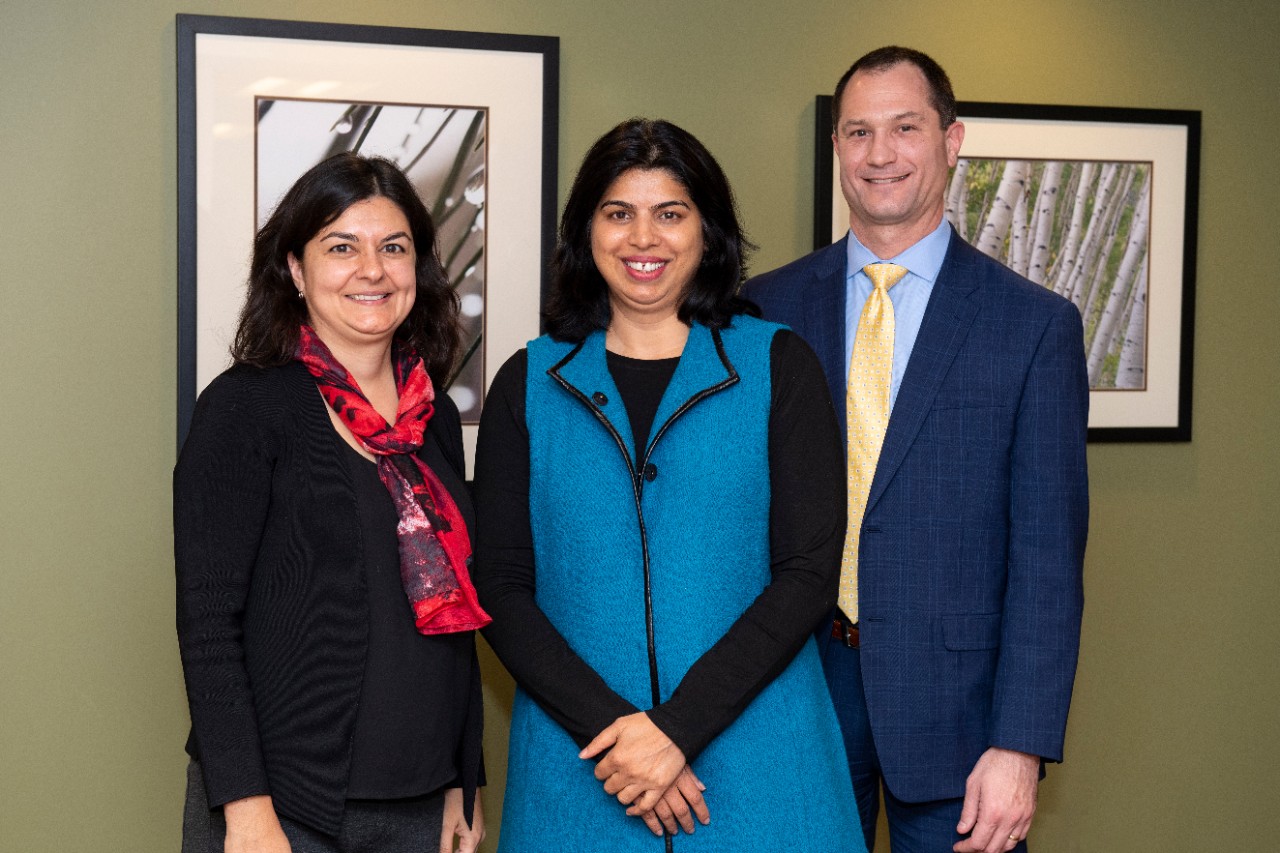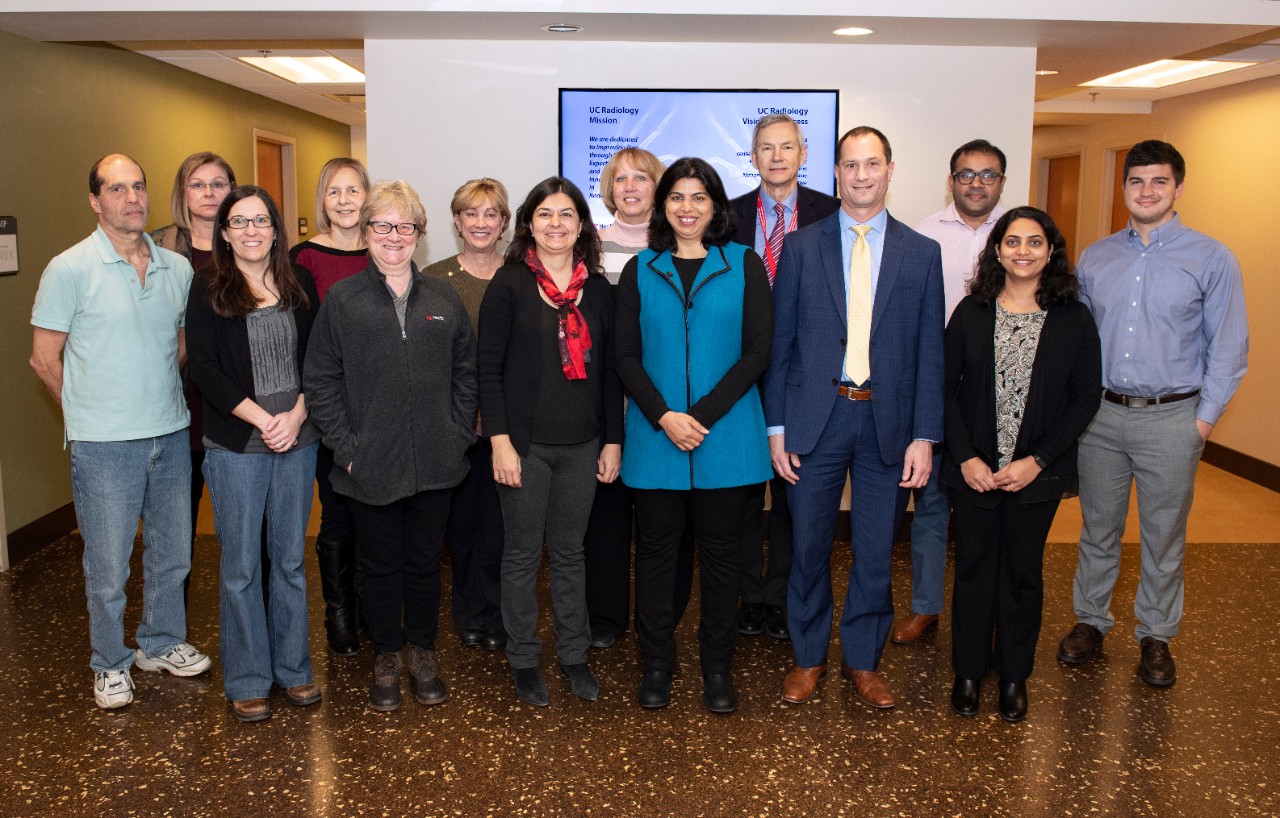
UC awarded $3.2 million to study stroke recurrence risk
Neuroimaging researchers will look for signs of small vessel disease in the brain to help identify patients at higher risk for stroke
Researchers at the University of Cincinnati (UC) have received a $3.2 million grant from the National Institute of Neurological Diseases (NINDS) to study the use of neuroimaging to pinpoint the risk factors of stroke recurrence.
It is the first-ever R01 grant for the Department of Radiology at the UC College of Medicine. Achala Vagal, MD, associate professor and vice chair of research in the Department of Radiology, is the principal investigator (PI) on the study, along with co-PIs Pooja Khatri, MD, professor of neurology and director of the UC Stroke Team, and Brett Kissela, MD, Albert Barnes Voorheis Professor and Chair of the Department of Neurology and Rehabilitation Medicine and senior associate dean for clinical research.
Recurring stroke makes up about 25 percent of all stroke cases—nearly 800,000 annually—in the U.S. alone. Someone who has suffered a stroke has an increased risk of a recurring stroke for up to five years after the initial event.
“Compared to our understanding of the risk factors of an initial stroke, we have limited understanding of the factors surrounding recurrent strokes,” says Vagal.
Titled APRISE (Assessing Population-based Radiological brain health in Stroke Epidemiology), the study will build off of the Greater Cincinnati Northern Kentucky Stroke Study (GCNKSS), a compilation of population-level stroke data since the 1990s that has been the source of national data on stroke in numerous studies.
“We hope by looking at imaging of small and large vessel disease in the brain, we could determine an accurate measure of a patient’s brain health or a predictor of future cerebrovascular events, like stroke or vascular dementia,” says Vagal, whose research is focused primarily on what happens to the brain and blood vessels after an initial stroke.

Pooja Khatri, MD, Achala Vagal, MD, and Brett Kissela, MD, of the UC College of Medicine, are all investigators on a new grant to study stroke recurrence. Photo/Colleen Kelley/UC
Vagal and neuroimaging researchers will assess imaging for signs of small vessel disease in the brain; this can be in the form of previous injury, microbleeds, white matter disease (wearing away of tissue) or brain atrophy, among other observations. This type of focus on small vessel disease is an area of priority for NINDS.
“The development of a clinical prediction tool, incorporating our full range of modern imaging techniques, will enhance our ability to identify patients at a higher risk for recurrent strokes,” says Vagal.
She adds that imaging is a critical component of almost all clinical research and it is very beneficial to have radiologists actively involved in study design and reading the scans.
Khatri says this award leverages the extensive infrastructure of the GCNKSS already in place and puts “[UC] in a unique position to characterize brain health with remarkable efficiency and generalizability.”
The new R01 is a milestone for both Vagal and the Department of Radiology, and she acknowledges the great support and mentors she had to help her pursue research work in neuroradiology. Vagal was a previous recipient of research and career development support from the American Roentgen Ray Society and the Center for Clinical and Translational Science and Training (CCTST). Khatri was her primary mentor for both these career development awards.
“The mentorship of Dr. Khatri has been critical for my career. I have always had incredible support from the radiology department, but to have additional cheerleaders in neurology and the UC Stroke team is an added advantage; it really does feel like my second home,” says Vagal.
“It has been incredibly gratifying to mentor Dr. Vagal, to see our radiology department grow its research portfolio and to now partner with her to achieve our synergistic goals. It has also been very rewarding to see our community work together toward better stroke care regionally and nationally,” notes Khatri.
Members of the central neuroimaging core include UC neuroradiologists Thomas Tomsick, MD; Mary Gaskill-Shipley, MD; Rebecca Cornelius, MD; and Lily Wang, MD. Shantala Gangatirkar will be the imaging coordinator for the study, and the biostatistical core will be housed at Cincinnati Children’s, led by Heidi Sucharew, PhD.

The APRISE grant research team includes (from left to right): Paul Horn, Janice Carrozzella, Heidi Sucharew, Mary Haverbusch, Rebecca Cornelius, Mary Gaskill Shipley, Pooja Khatri, Kathleen Alwell, Achala Vagal, Thomas Tomsick, Brett Kissela, Vivek Khandwala, Shantala Gangatirkar and Johnathan Vidovich. Photo/Colleen Kelley
About the Greater Cincinnati Northern Kentucky Stroke Study
In 1993, the GCNKSS was designed by Joseph Broderick, MD, now director of the UC Gardner Neuroscience Institute, to be the first large, population-based metropolitan study of trends in stroke incidence rates and outcome within a biracial population. Over the past 22 years, the study has produced numerous major findings, particularly with regard to racial disparities in stroke.
"Our area’s population is similar to that of the United States in terms of age, economic status and racial makeup,” says Kissela, who is co-PI for the long-running study along with Dawn Kleindorfer, MD, "so it’s a great resource for understanding stroke, not only for our community but also as a generalized model for the country.”
Featured photo at top: Achala Vagal. All photos by Colleen Kelley / AHC Communication Services.
Related Stories
Cancer Center, Dana-Farber, more receive $1.2M from family...
March 28, 2025
The Cincinnati Business Courier highlighted a $1.2 million grant received by the University of Cincinnati Cancer Center's Timothy Phoenix and colleagues at Dana-Farber Cancer Institute and the German Cancer Research Center to study pediatric low-grade gliomas.
Kentucky mom shares her colon cancer journey to save others
March 26, 2025
University of Cincinnati Cancer Center patient Patty Goering and physician researcher Tahir Latif spoke with WLWT about Goering's story of being diagnosed and treated for colon cancer at a young age.
President Pinto shares search update for executive vice...
March 25, 2025
President Neville Pinto shares search update for executive vice president for academic affairs and provost
